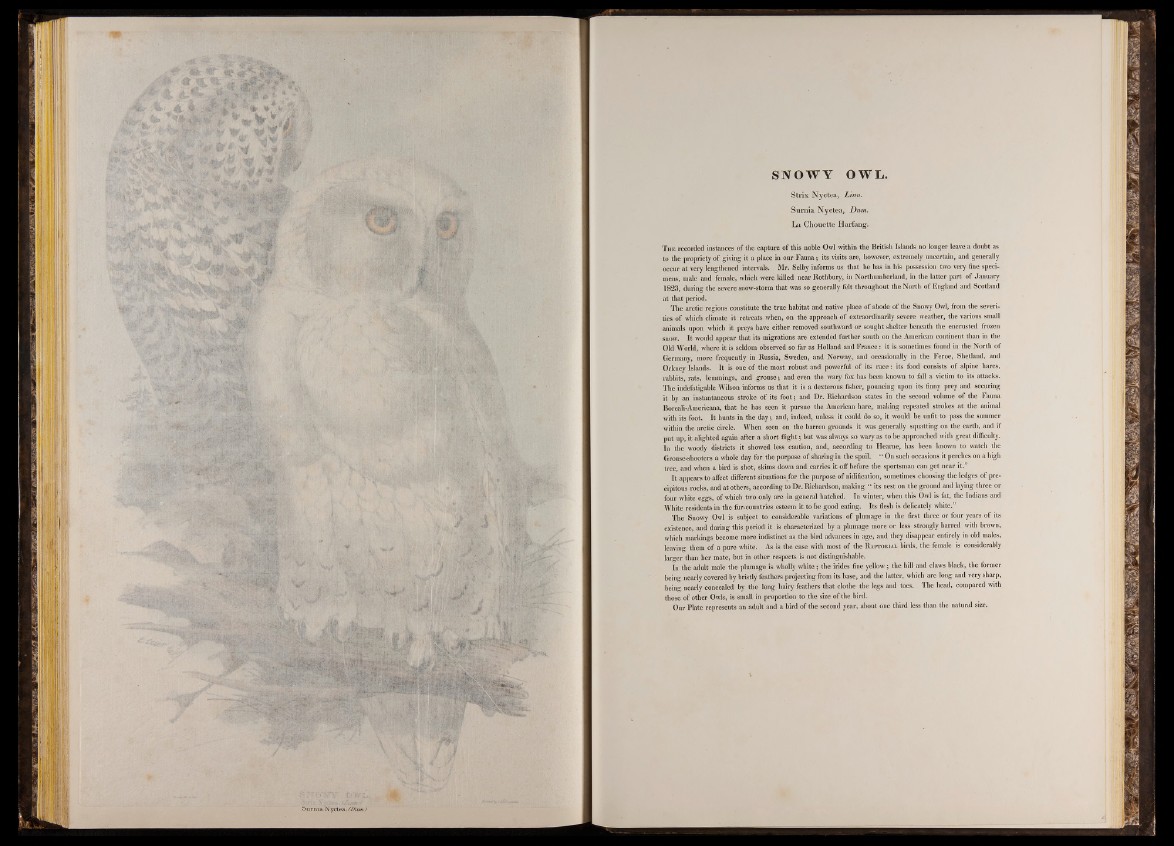
W vw
S u r m a N y c te a -. fD u m .)
SNOWY OWL.
Strix Nyctea, Linn.
Surma Nyctea, Dum.
La Chouette Harfang.
T he recorded instances of the capture of this noble Owl within the British Islands no longer leave a doubt as
to the propriety of giving it a place in our Fauna; its visits are, however, extremely uncertain, and generally
occur at very lengthened intervals. Mr. Selby informs us that he has in his possession two very fine specimens,
male and female, which were killed near Rothbury, in Northumberland, in the latter part of January
1823, during the severe snow-storm that was so generally felt throughout the North of England and Scotland
at that period.
The arctic regions constitute the true habitat and native place of abode of the Snowy Owl, from the severities
of which climate it retreats when, on the approach of extraordinarily severe weather, the various small
animals upon which it preys have either removed southward or sought shelter beneath the encrusted frozen
snow. It would appear that its migrations are extended further south on the American continent than in the
Old World, where it is seldom observed so far as Holland and France: it is sometimes found in the North of
Germany, more frequently in Russia, Sweden, and Norway, and occasionally in the Feroe, Shetland, and
Orkney Islands. It is one of the most robust and powerful of its race: its food consists of alpine hares,
rabbits, rats, lemmings, and grouse; and even the wary fox has been known to fall a victim to its attacks.
The indefatigable Wilson informs us that it is a dexterous fisher, pouncing upon its finny prey and securing
it by an instantaneous stroke of its foot; and Dr. Richardson states in the second volume of the Fauna
Boreali-Americana, that he has seen it pursue the American hare, making repeated strokes at the animal
with its foot. It hunts in the day; and, indeed, unless it could do so, it would be unfit to pass the summer
within the arctic circle. When seen on the barren grounds it was generally squatting on the earth, and if
put up, it alighted again after a short flight; but was always so wary as to be approached with great difficulty.
In the woody districts it showed less caution, and, according to Hearne, has been known to watch the
Grouse-shooters a whole day for the purpose of sharing in the spoil. “ On such occasions it perches on a high
tree, and when a bird is shot, skims down and carries it off before the sportsman can get near it.”
It appears to affect different situations for the purpose of nidification, sometimes choosing the ledges of precipitous
rocks, and at others, according to Dr. Richardson, making “ its nest on the ground and laying three or
four white eggs, of which two only are in general hatched. In winter, when this Owl is fat, the Indians and
White residents in the fur-countries esteem it to be good eating. Its flesh is delicately white.”
The Snowy Owl is subject to considerable variations of plumage in the first three or four years of its
existence, and during this period it is characterized by a plumage more or less strongly barred with brown,
which markings become more indistinct as the bird advances in age, and they disappear entirely in old males,
leaving them of a pure white. As is the case with most of the R aptorial birds, the female is considerably
larger than her mate, but in other respects is not distinguishable.
In the adult male the plumage is wholly white; the irides fine yellow; the bill and claws black, the former
being nearly covered by bristly feathers projecting from its base, and the latter, which are long and very sharp,
being nearly concealed by the long hairy feathers that clothe the legs and toes. The head, compared with
those of other Owls, is small in proportion to the size of the bird.
Our Plate represents an adult and a bird of the second year, about one third less than the natural size.